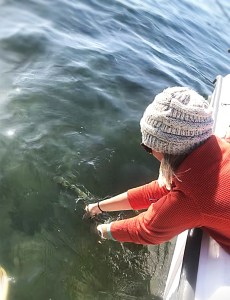Renaming October- Fishtober
October is always a bitter sweet month to be a fishermen in Puget Sound. The fishing is always pretty good out in Puget Sound, but it does not get better than October. Sure spring is great, summer is fantastic, and Winter has amazing flats fishing… But October… Oh goodness. Fishing in October is down right perfect (November is pretty sweet as well). However, there are a few down sides… October marks the end of any hope for flip flops and shorts. It ends any hope of the occasional bikini hatch at the resorts (I hear the comments from the dirty old guys!). No more swimming when we take a break for a snack. All of that aside, it’s perfect fishing, and I suppose what more could we ask for?
Get To The Point Will Ya!
What makes October perfect for fishing? Well, I have asked myself this for about 8 years now. I think after a ton of contemplation I am finally ready to say… It’s complicated. Cold weather, less bait, concentrated fish, experience.
Chill Pill
Let’s start with Octobers weather, it’s unpredictably predictable. October will average air temps in the 50’s. Which means we will see similar air temperatures to sea run cutthroats favorite water water temperatures. In conclusion there will not be a die off in the feeding throughout the day. In contrast, July is wonderful, but once the mercury peaks, we are probably done with the best fishing for the day.
Fish Snacks
Moving on from weather, is food sources. October sees a decrease in baitfish from Septembers endless supply of fatty protein. The fish are still fat and happy, and obviously still well fed. However, the pickiness you see in late august/early september is completely void in October. If you are going to be forced to put shoes on to go fishing for the first time of the year, you might as well fish to happy slob fish.
October Is For Concentration
Continuing on down the list… I always say October is the perfect time of year to fish for Sea Run Cutthroat, this is only true if you find them. Cutthroat concentrate together way more in October-December. In the summer we do these endless drifts down shorelines fishing every pocket and piece of structure. When October hits (the first big cold spell) we notice that the fish concentrate more on certain spots. Will we catch a single fish once in a while if we drift? Sure! Often though, you will find vacant beaches where we fish in the summer. Those fish have moved onto their cold weather holds. However, if you find the pods of feeders, we tend to double up, or have a dozen fish follow the fly in. This is the time of year we will have a small fish eaten off the line by a larger cutthroat.
Time Served
Last is experience. When we first started fishing for cutthroat we were stuck to the beach. We fished the public (and often private) beaches that we knew we could pull a few fish. The cold weather would come and some of these beaches would be best suited for contemplating life, and others would all of a sudden make you feel like a fishing god. As we started exploring more, spending more time on the water, and getting off the beach, it became clear how these fish behave, and we started growing opinions on why. This is a great time of year to pay attention to the successes and failures on the water. October changes things out there more than any other time of the year.
October is here, we are stoked. To be completely honest, all of the cold months are pretty wonderful. We will give you the tips on how to take advantage of it soon.










































